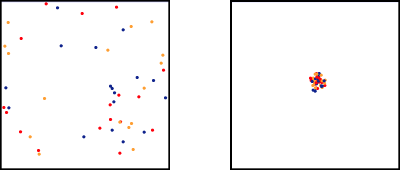Simple rules and the complexity of collective behavior
It should be pretty straightforward why the agent-based models appear to be very simple. They do poses technical simplicity, which my cause some doubts on the actual usefulness of the agent-based models. But the fact is that they are able to reproduce complex, non-trivial behavioral patterns.
There numerous examples for this. One of the most simple, yet very
persuasive, is made available on the Icosystem website (see
http://www.icosystem.com/demos/thegame.htm). This model by Icosystem
discribes a very simple game, which can be played with living people.
The main point of the game is to stay in certain position relative to
two other randomly selected agents (or people). In one case, in the
defender-aggressor scenario, the agent tries to stay behind one of the
selected agent (defender) to be protected from the other (aggressor). In
another case, the defender-defender scenario, both randomly selected
agent are assumed to be defending the agent from the external influence,
thus he tries to stay between them. Neither of agents are cooperating -
they just move to take their own positions to fulfill their scenario
conditions. As you can see in the figure below the small
difference in the game rules causes essential changes in the externally
observed behavior.

